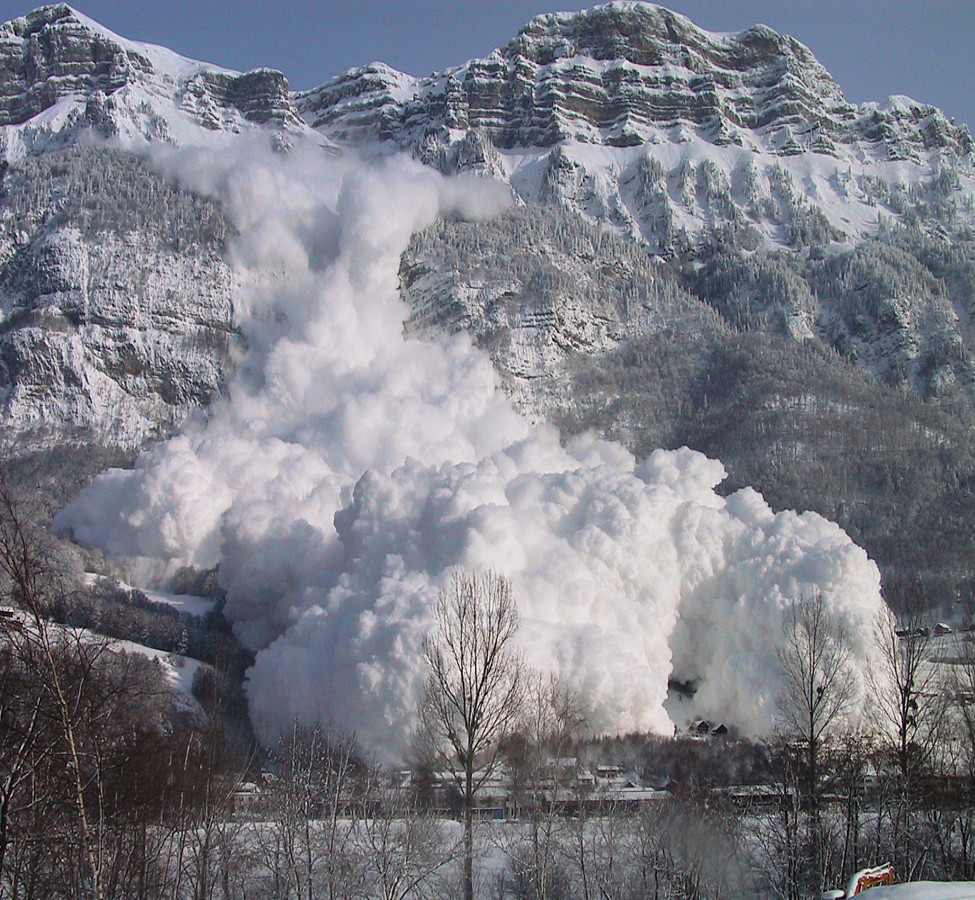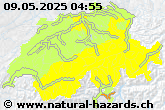2000 - 2010
23 July 2009
Hail from the canton of Vaud to Lake Constance
Following on from foehn wind conditions a thunderstorm swept across the cantons of Vaud, Fribourg, Bern, Lucerne and Nidwalden. Damage to the tune of CHF 250 million was caused by hail, in particular, and to a lesser extent by storm winds and flooding. Individual squalls reached speeds of over 100 km/h. Hailstones up to the size of a tennis ball size (> 5 cm) fell in French-speaking Switzerland.
30 May 2008
Glacial Lake Outburst on Lower Grindelwald Glacier
The Lower Grindelwald Glacier is shrinking which means that the flanks of the valley are no longer supported by the glacier ice. This gives rise to instabilities and rockfall onto the glacier. The retreat of the glacier caused a basin to form which is filled with melt water when the snow melts and does not have any overground drainage. As a result of the contact between the water and ice and the pressure of the rising lake level, openings form in the ice on the floor of the lake through which the water drains. Due to the ongoing extension of the drainage channel, very large volumes of water can flow out of the lake in a very short period of time. An outburst of this kind occurred on 30 May 2008. The peak lake volume was 800,000 m³. The emptying process took approximately three hours and the lake volume was reduced to around 200,000 m³ as a result. Major overbank flooding also arose in the Grindelwald area causing cultural damage. If the glacial outburst had coincided with a precipitation event (e.g. thunderstorm), the extent of the damage could have been significantly higher.
08/09 August 2007
Flooding in Switzerland
The persistent rain of 8 and 9 August 2007 gave rise to critical situations and flood damage in many cantons of northern Switzerland. The intensive precipitation caused a rapid increase in discharge in the river Aare and its tributaries and both above and below the Jura lakes (Lake Biel, Lake Neuchâel and Lake Murten). Very high discharge volumes were generally recorded in the river Emme, the Aare from its confluence with the Emme to the river Rhine, and in Birs and Ergolz. Lake Biel reached a record high for the period after the second Jura water correction. The scope for regulation of the Jura lakes reached its limits. Compared with the flood of August 2005, more areas in the Central Plateau, in Jura and in Chablais were affected.
3 October 2006
Mudslide near Biasca (TI)
On the Bridge of Ponte Rosso near Biasca, a woman died when her car buried underneath a mudslide.
11 July 2006
Mudslide in Val Roseg (GR)
The melt water from the Vadret da l’Alp Ota, a small glacier in the Val Roset, triggered a mudslide at an altitude of 2900 meters. As the mass of water, mud and debris rolled down towards the valley it covered several hiking trails. A German tourist hill-walking in the area was caught by the slide and buried in the mud. She died before the rescuers could excavate her.
13 July 2006
Eiger Rockfall
On 13 July 2005, approximately 500,000 m³ of rock broke off from a large rock mass on the Eiger above Grindelwald that was vulnerable to rockfall and fell onto the Lower Grindelwald Glacier. The piece of rock on the eastern flank of the Eiger fell onto the glacier in three sections. The splitting of the mountain rock was clearly caused by stresses discharged following the retreat of the Grindelwald Glacier. The Eiger rockfall came as no surprise to experts and the population. A rock mass of two million cubic meters had been on the move there from June 2006.
31 May 2006
Rockfall in Gurtnellen
On the morning of 31 May 2006 a rockfall event occurred to the south of the Güetli tunnel affecting the A2 motorway and the cantonal road. A total of around six boulders, each approximately 10 m³ in size, fell onto the roads. Two trucks were hit and one car, both of whose passengers were killed. The original volume of the rockfall was almost 10,000 10 m³ rock and stone. The further risk of rockfall in the location was averted by blasting.
21/22 August 2005
Floods in Switzerland
In August 2005, torrential rain fell across wide areas on the northern slopes of the Alps, in some instances more rain fell than had ever been seen in Switzerland since records began. Lake levels reached record highs, rivers and streams generated extraordinary levels of discharge and landslides occurred on slopes. The main damage processes were flooding, erosion, overbank sedimentation, landslides and debris flows. The flood of August 2005 in Switzerland claimed the lives of six people and caused material damage totalling CHF 3 billion. Approximately 900 communes were affected and locations like Engelberg and Lauterbrunnen remained cut off for days. Overall, and viewed from a longer-term perspective, however, this event can at best be described as rare rather than extraordinary.
1 August 2003
Leuk forest fire (Valais)
During the heat wave summer of 2003 a forest fire broke out in a forest above Leuk in the canton of Valais. Local winds ensured the rapid spread of the fire in the arid forest. The villages of Albinen, Leuk and some hamlets were at risk from the fire and people had to be evacuated from them. The fire destroyed approximately 450 ha of forest. The fire area extended from 800 m asl to the forest line at 2,100 m asl. Approximately 60 ha of the affected forest was protective forest which provided avalanche and rockfall protection to Leuk and the road to Leukerbad.
May-October 2003
Heat Wave Summer 2003
The summer of 2003 was one of the hottest of the past century throughout Europe. In Switzerland, the temperatures recorded for the meteorological summer (mean for the months of June, July and August) were 4-5.5°C higher than the long-term mean value for the period 1864-2003. The drought of 2003 was not a phenomenon limited to the summer, however, it started in February and lasted in some regions until October or November. In meteorological terms, the heat and drought between May and October 2003 can be explained by the extreme frequency of subtropical high-pressure areas over Central Europe which exerted an almost permanent influence on the continent’s weather. The effects of the heat were clearly evidenced in Switzerland by the almost 1,000 fatalities caused; the number of fatalities caused by the heat wave for all of Europe is estimated at as many as 35,000. Other effects of the heat wave summer were failed harvests, animal feed scarcities, low water and ground-water levels and high temperatures resulting in water shortages and fish death, and the thawing of the permafrost soils which resulted in a large number of rockfall events.
31 August / 01 September 2002
Landslide in Lutzenberg (Appenzell Outer Rhodes)
Stationary and intensive storms, involving considerable volumes of precipitation, in part, arose in the northern Pre-Alps of central and east Switzerland. Numerous instances of flooding and landslides occurred as a result. A landslide which demolished a house occurred on the night of 31 August/1 September in Lutzenberg in the Canton of Appenzell Outer Rhodes. There were three fatalities as a result of this event.
14th October 2000
Storm in Valais
Several debris flows killed 16 people. The most severe event happened in Gondo when the mudslide damed behind a protective wall against rockfall. The wall could not hold the pressure any longer and collapsed. The mixture of water, soil, mud and parts of the protection wall (weighing tons) avalanching down now destroyed within seconds one third of the village. In Stalden-Neubruegg the Breiter torrent– most probably dammed by a landslide – washed away four houses and killed two people. Near Martigny a woman was buried in her car underneath the mud and was brought out of the mud dead. As everything happened so fast, there was no time for warning (which is given usually with flooding, due to the slow ascending of water level).



